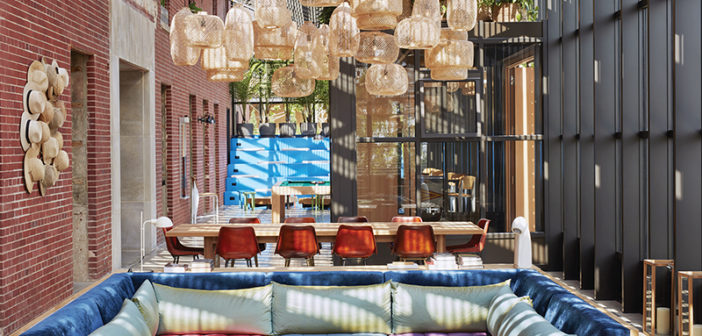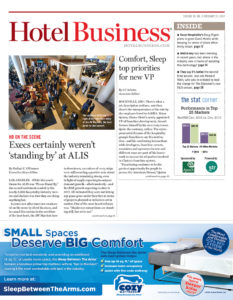Once blighted with vacant, dilapidated buildings, Asbury Park’s waterfront is now grabbing the spotlight for its multibillion-dollar revitalization. Among the players staging the New Jersey city’s comeback—10 years in the making—is iStar, a real-estate investment company that owns 35 acres of land along the waterfront, and last year launched with veteran hotelier David Bowd, The Asbury, a 110-key boutique hotel as part of a strategic plan to make this seaside spot a year-round destination.
“There’s been a slight resurgence since around 2002, with some revitalization downtown and along the waterfront and spreading to other parts of the community. The success of the development of the waterfront creates new jobs and lifts up the city. Many hands make light work,” said Brian Cheripka, SVP of land and development, iStar. “We’re excited to be a part of it and we’ve seen a lot of progress in the last five or six years since taking a direct role in the redevelopment. The city is welcoming the changes that are occurring here, and there are a lot of people working to make it happen.”
It takes a village to build a hotel—its first in more than 50 years—and revitalize a city, no less. iStar’s Anda Andrei is the creative lead for the entire redevelopment project here. The roster of talent enlisted for The Asbury project included some heavy hitters—owner/operator David Bowd, CEO of Salt Hotels; Stonehill & Taylor Architects; Bonetti Kozerski Studio; Andre Balazs, CEO of André Balazs Properties; and fashion designer Donna Karan.
There’s an energy building in the city’s favor, with The Asbury serving as a key transformational asset imbued with the power to change people’s perceptions of what the neighborhood has been over the past few years into what it is gradually becoming today.
“What I always enjoy hearing the most is when people who haven’t been here in a while visit and they have this historical perspective. Then they see the new landscaping, the boardwalk lights and the hotels, as well as the other aspects, and they can feel the momentum in the city,” said Cheripka. “The Asbury is a huge part of that. It gives consumers choices,” he said, noting that before, they had few choices when it came to where to stay. That’s why iStar made the decision to invest in a hotel.”
A conversion of a former Salvation Army outpost, The Asbury now serves its community in a decidedly different way, and the overall design amps up the fun to be had on-property with 35,000 sq. ft. of public spaces—a rec room with nostalgic games, an activated lobby and rooftop bar, sunken living room, a music venue, a beer garden and a newly added ice-skating rink. The limited-service hotel is just one of 20 developments iStar has planned for the area. Across the street, construction is underway on a mixed-use project that will house a 54-key, full-service hotel complete with residences and ground-floor retail space.
“We’re basically extending the consumer base. They’ll be right across the street. One of the things we recognize is that the long-term goal is to bring choices. The hotel at 1101 Ocean will serve a different set of customers—more affluent—while The Asbury always has something happening, and that was part of the original design. Anda created all of these unique places that seamlessly work together,” said Cheripka. “We asked ourselves, ‘How do we make this place special?’ We brought in different architects for each project… We don’t want everything to be the same.”
Vacant since 2004, the former Salvation Army building was boarded up and vandalized. The interior had to be gutted as there was significant water damage and the roof, now sprouting grass after years of neglect, had lived past its prime, noted Cheripka.
“It was in pretty bad shape. The brick needed to be repointed because of moisture that penetrated it. We took it down to its concrete core and removed the floor at the ground level. We expanded the footing and put in new structural steel. It was a complex conversion,” he said. “The building was originally built in two parts. The main component was built in the 1950s and the smaller section was added in the 1970s. It was an older building and that, in conjunction with no one caring for it since 2004, made it a lot of work to become what it is today.”
A building conversion offers the opportunity to mix old and new design elements as a way of paying respect to its former life yet introducing a fresh point of view. Cheripka’s team cut through old window penetrations down to the floor; installed a greenhouse with an architectural glass feature to lend an industrial feel to the space; and a sunken living room added a touch of cozy. Inside the lobby, there’s new woodwork and guests can see the new steel attached to the old building, noted Cheripka.
“How all these different materials come together and blend the old and new gives a warm feeling. You can come in any weekend and people are hanging out in the lobby and listening to music. It’s got a community vibe,” he said. “It’s Anda’s original design concept. I think she did a fantastic job and that’s why The Asbury has earned recognition—Best New Hotel in USA Today’s 2017 Reader’s Choice Awards.”
Despite the accolades and progress on the redevelopment, Cheripka noted that he’s seen his fair share of critics and naysayers resistant to change. As a Jersey native who spent summers up and down the shoreline, he remembers Asbury Park’s past and is committed to changing minds and delivering on the company’s promise to the city.
“We demolished 25 buildings since I arrived. They say, ‘You’re losing the spirit of the city.’ It’s just the opposite. There were damaged buildings and we want to take those eyesores down and put in sidewalks and landscaping,” he said. “This development will be complete in 10 to 12 years, maybe sooner. We can fix up the property and change the way people feel. We want them to feel safe. Vacant buildings attract crime and problems. We took down buildings with no functional use and made the decision to save the Salvation Army and the bowling alley behind it. The story of The Asbury is mixing old and new and it’s what iStar is all about. A lot of developers said, ‘I’m going to do it,’ but no one ever did anything. When the opportunity presented itself, we bought the note from a bank that didn’t have any interest in the property, went through the foreclosure process and said, ‘What can we do with this? We’d like to try and save it.’” HB


